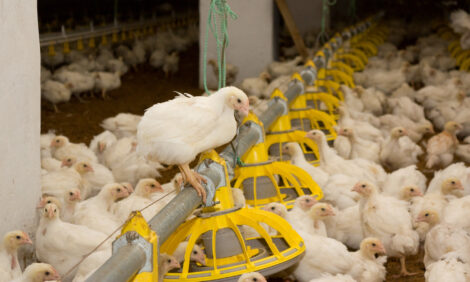



US Broiler Health Shows Slight Decline
Published in Poultry Health Report - Fall/Winter 2007 a National Institute for Animal Agriculture Publication. In his broiler industry update presentation at the recent meeting of the US Animal Health Association (USAHA), Dr. Scott Westall, Pilgrim’s Pride, reported that US broiler flock health has seen a slight decline over the past year, according to yearly Agristats data for field condemnations, seven-day mortality and total mortality.The decline was seen across all three parameters and is most likely due to continued problems with Infectious Laryngotracheitis (ILT) and Runting Stunting Syndrome (RSS). A poll of broiler production veterinarians ranked these as the top two disease challenges facing the industry in 2007, Dr. Westfall said.
Laryngotracheitis (ILT) and Runting Stunting Syndrome (RSS). A poll of broiler production veterinarians ranked these as the top two disease challenges facing the industry in 2007, Dr. Westfall said.
In the poll, ILT and Mycoplasmosis were the two highest-ranking respiratory diseases.
| Vaccinal Laryngotracheitis (VLT) is an acute viral respiratory disease primarily of chickens, which occurs in native flocks of chickens following vaccination of others with live vaccine. Economic losses attributable to VLT have been important in many poultry producing areas throughout the United States and the world. Despite efforts to control the disease through vaccination and implementation of biosecurity measures, outbreaks of VLT are still a threat to the poultry industry. Over the past year, additional field evaluations of the VLT vaccine in broilers by the in ovo route of vaccination have been conducted. Some reported that the in ovo dose has been reduced to lessen the effect of the vaccine on hatchability and seven-day mortality. In the field, the vaccine did stop the spread of VLT between flocks in some locations. However, it has been reported that in "hot areas" in ovo vaccinated broiler flocks did break with VLT. Clinical signs and mortality was reduced but not prevented. FP-LT has also been used in ovo in combination with the CEO field boost at 2 - 2.5 weeks of age. It was noted that the in ovo vaccination FPLT appears to “buffer” the reaction to the CEO vaccination. |
RSS, Gangrenous Dermatitis (GD) and Infectious Bursal Disease (IBD) are the three top-ranking immunosuppressive diseases.
A consensus on the causative agent or agents of RSS has not been reached.
However, there is no doubt that RSS-related immunosuppression has impacted flock uniformity and processability and increased the incidence of secondary infections with GD and Inclusion Body Hepatitis (IBH). IBD is also frequently implicated in these secondary infections.
Coccidiosis and Necrotic Enteritis (NE) are the top-ranking enteric diseases. These issues are probably related and may take a more prominent role as feed costs increase.
Avian influenza (AI) has not directly impacted US broiler flocks although two low or mildly pathogenic avian influenza outbreaks in commercial turkey flocks led to increased surveillance for broiler flocks in close proximity to the breaks. Broiler veterinarians indicate that a lot of time is still being devoted to AI education and contingency planning.
Antibiotic usage and nutrition will play a more prominent role in broiler health in the coming year. Lack of effective antibiotics to treat diseases and increasing demand for "antibiotic free" production will increase the need for creative disease control and prevention strategies to maintain our current high level of health, welfare and productivity.
Nutritional strategies are also changing due to high input costs. Veterinarians will be challenged to make sure the nutritional needs of the birds are met. Failure to do so could result in classical deficiency diseases and immunosuppression.
Ranking of Disease Concerns among 17 Broiler Production Veterinarians
| Roundworms | 1 |
| Inclusion Body Hepatitis | 1 |
| Cholera | 1 |
| Airsacculitis | 1 |
| Necrotic Enteritis | 2 |
| Legs- Skeletal Issues | 2 |
| Infectious Bronchitis Virus | 2 |
| Coccidiosis | 2 |
| Infectious Bursal Disease | 3 |
| Chick Quality | 3 |
| Mycoplasmosis | 5 |
| Gangrenous Dermatitis | 6 |
| Runting Stunting Syndrome | 8 |
| Infectious Laryngotracheitis | 12 |
Ranking of Non-Disease Concerns among 17 Broiler Production Veterinarians
| Litter Supply | 1 |
| Litter Beetles | 1 |
| Dead Bird Disposal | 1 |
| Food Safety | 1 |
| Feed/Nutrition | 2 |
| Avian Influenza (education & planning) | 2 |
| Welfare | 3 |
| Management | 3 |
| Antibiotic Issues | 6 |
February 2008









